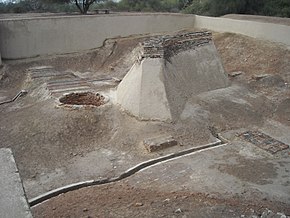Harappa
| ہڑپّہ (Urdu) | |

A large well and bathing platforms are remains of Harappa's final phase of occupation from 2200 to 1900 BC.
|
|
| Location | Sahiwal District, Punjab, Pakistan |
|---|---|
| Coordinates | 30°37′44″N 72°51′50″E / 30.62889°N 72.86389°ECoordinates: 30°37′44″N 72°51′50″E / 30.62889°N 72.86389°E |
| Type | Settlement |
| Area | 150 ha (370 acres) |
| History | |
| Periods | Harappa 1 to Harappa 5 |
| Cultures | Indus Valley Civilization |
| Site notes | |
| Condition | Ruined |
| Ownership |
|
| Public access | Yes |
Harappa (Punjabi pronunciation: [ɦəɽəppaː]; Urdu/Punjabi: ہڑپّہا) is an archaeological site in Punjab, Pakistan, about 24 km (15 mi) west of Sahiwal. The site takes its name from a modern village located near the former course of the Ravi River. The current village of Harappa is 6 km (3.7 mi) from the ancient site. Although modern Harappa has a legacy railway station from the period of the British Raj, it is today just a small crossroads town of population 15,000.
The site of the ancient city contains the ruins of a Bronze Age fortified city, which was part of the Cemetery H culture and the Indus Valley Civilization, centered in Sindh and the Punjab. The city is believed to have had as many as 23,500 residents and occupied about 150 hectares (370 acres) with clay sculptured houses at its greatest extent during the Mature Harappan phase (2600–1900 BC), which is considered large for its time. Per archaeological convention of naming a previously unknown civilization by its first excavated site, the Indus Valley Civilization is also called the Harappan Civilization.
...
Wikipedia

